The Surprising Way the Queen’s Father Hid the Crown Jewels During WWII
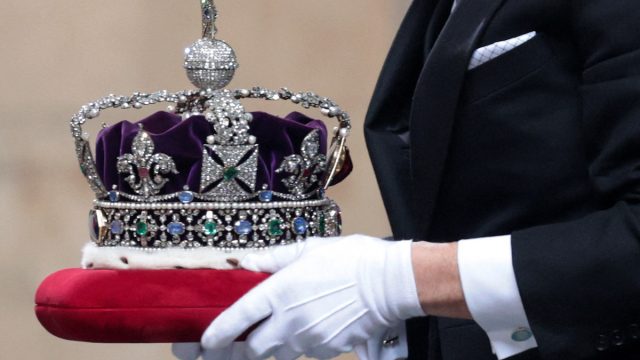
Heavy is the head that wears the crown—and that’s particular true of the Imperial State Crown, one of the most iconic “Crown Jewels” of Britain, which weighs in at nearly two pounds. One of the most awe-inspiring pieces in the Crown Jewels’ collection, the showstopper contains 2,868 diamonds, 17 sapphires, 11 emeralds, 269 pearls, and 4 rubies. In 1953, Queen Elizabeth wore the stunning symbol of the British monarchy at her own coronation celebration (though it was the St. Edward’s Crown that was placed on her head at the defining moment). She has also worn the crown on other formal occasions, including the State Opening of Parliament.
The Imperial State Crown was made in 1937 for King George VI (the Queen’s father) as a replica of the crown made for Queen Victoria in 1838 with nearly all the same stones. In a rare television interview for the 2018 documentary The Coronation, which chronicles the moment she went from Princess Elizabeth of York to Queen, Her Majesty told interviewer Alastair Bruce that the Imperial State Crown was “very unwieldy” when she’s worn it. “You can’t look down to read the speech—you had to keep the speech up, because if you did not, your neck would break, or it would fall off,” she said.
Today, security is extremely tight around the Crown Jewels, which have been housed in the Tower of London since the 1600s. Visitors to the Tower can view the dazzling diadem in a darkened room in the Jewel House protected by armed guards and kept under specially-made bulletproof glass. Guests cannot stop in front of the Imperial State Crown, but instead stand on an airport-style conveyor belt, which moves at a brisk place to prevent anyone from lingering over the dramatic display.
Back when the Queen was just a child, safety measures to protect the precious jewels were far less sophisticated, however. Read on to find out what the Queen’s father did to hide the Crown Jewels from enemies during World War II and explore the stories behind other famous tiaras memorably worn by the women of the House of Windsor.
During World War II, King George VI ordered the jewels of the Imperial State Crown be stashed in a biscuit tin box and buried.
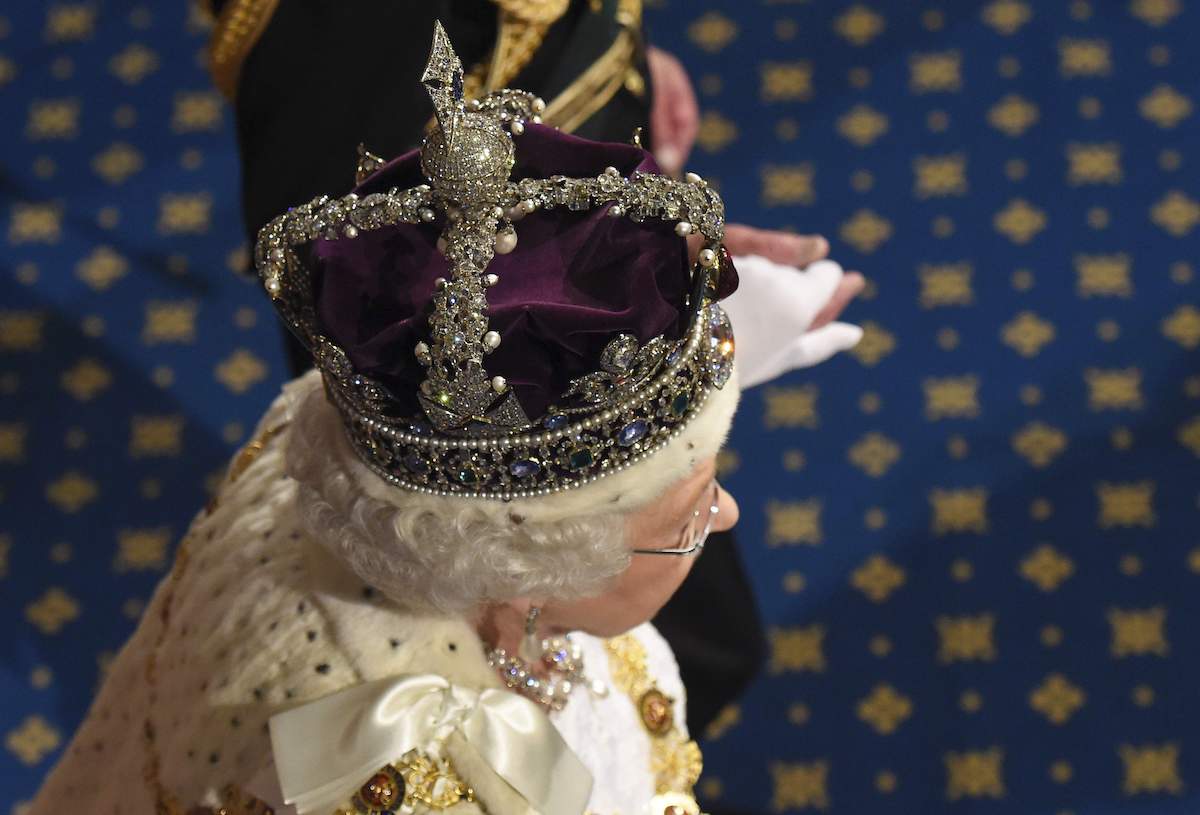
In The Coronation, it was revealed during World War II, King George VI ordered the jewels on the then newly created Imperial State Crown be removed from their setting and hidden in a biscuit tin and then buried in space dug beneath Windsor Castle. The Queen’s father directed this order be carried out in secret because he didn’t want priceless stones falling into Nazi hands.
The order was such a well-guarded secret that even the Queen, who was just 13 years old when she was sent to Windsor Castle with her sister, Princess Margaret, during WWII, knew nothing about it. She learned of her father’s decision to bury the jewels at the castle from Alastair Bruce, who’s a well-regarded British historian, while taping her interview for The Coronation documentary.
The story was revealed in letters found by Oliver Urquhart Irvine, a librarian and assistant keeper of the Queen’s Archives. The correspondence was written to King George VI’s mother, Queen Mary, by royal librarian Sir Owen Morshead, who told her about the King’s plans for the secret chamber. Bruce recalled telling Her Majesty the incredible story of her father’s actions later in an interview with The Times. “What was so lovely was that the Queen had no knowledge of it,” he said. “Telling her seemed strangely odd.”
And for more royals news sent right to your inbox, sign up for our daily newsletter.
Princess Diana’s Lover’s Knot tiara became instantly iconic.
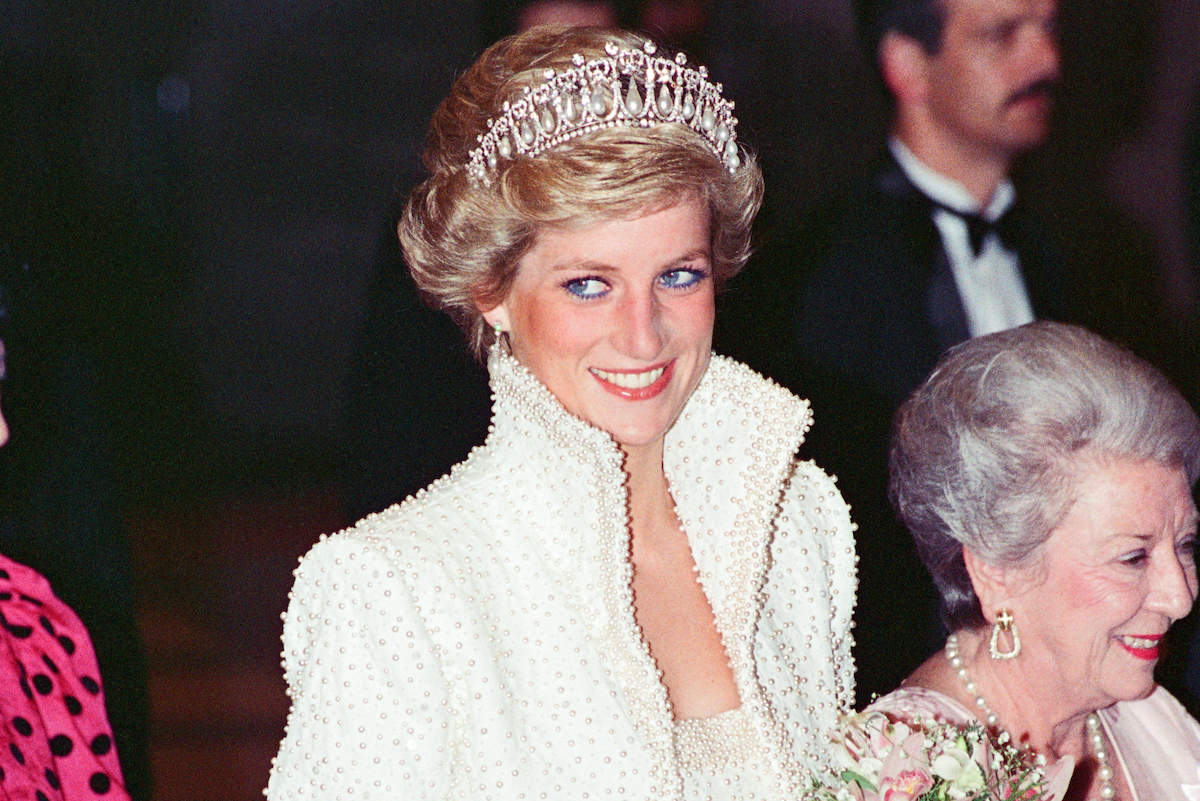
The women of the House of Windsor have memorably worn coronets that belonged to the Queen on their wedding days, as royal protocol dictates that only married women can wear tiaras. Though Princess Diana wore the Spencer family tiara (which had been worn by her two elder sisters, Lady Jane Fellowes and Lady Sarah McCorquodale, at their weddings) when she married Prince Charles in July 1981, she will forever be associated with the Lover’s Knot tiara, one of her favorite pieces given to her as a gift from the Queen that she wore on countless occasions. Per Tatler, the iconic tiara was first offered to Diana by the Queen to wear on her wedding day, but the future Princess of Wales chose her family heirloom instead.
The Lover’s Knot tiara was commissioned for Queen Mary in 1913 by the royal jeweler Garrard. Set in silver and gold, the tiara is covered with diamonds and ringed with 19 hanging baroque pearls. Queen Mary handed down the stunning crown to Queen Elizabeth, who eventually gave it to her new daughter-in-law.
The princess first wore the tiara to the Opening of Parliament just months after her wedding and then on several official state visits, but when she wore it with the famous Elvis dress and jacket designed by Catherine Walker in 1989 on a trip to Hong Kong (pictured), it was a defining moment in fashion history. The pearl encrusted dress perfectly complimented the regal tiara. She wore it again later that same year to the British Fashion Awards. In an interview for my book, Diana The Secrets of Her Style, the late designer Oscar de la Renta told me, “[Diana] had tremendous star quality and that dress created such a moment for her. When she walked into the room, there wasn’t anyone who didn’t notice. In that dress, she was a glittering vision.”
Diana so loved the Lover’s Knot tiara that she wore it often despite reportedly getting terrible headaches from it, according to Vogue. After her divorce from Prince Charles, however, the princess returned her favorite tiara to the Queen, the outlet reports.
In a touching tribute to her late mother-in-law, Catherine, Duchess of Cambridge, has shown the same affection for the timeless tiara, sometimes known as the Cambridge Lover’s Knot tiara. According to People, after Diana’s death in 1997, the tiara was not seen until 2015, when Kate wore it at a reception at Buckingham Palace. Since then, the duchess has chosen the sentimental piece for many state occasions, including the Diplomatic Corps annual reception in 2018.
RELATED: 10 Photos That Perfectly Capture Princess Diana’s ’80s Style Evolution.
Catherine, Duchess of Cambridge has also reworn one of her favorite pieces, the Lotus Tiara, many times.
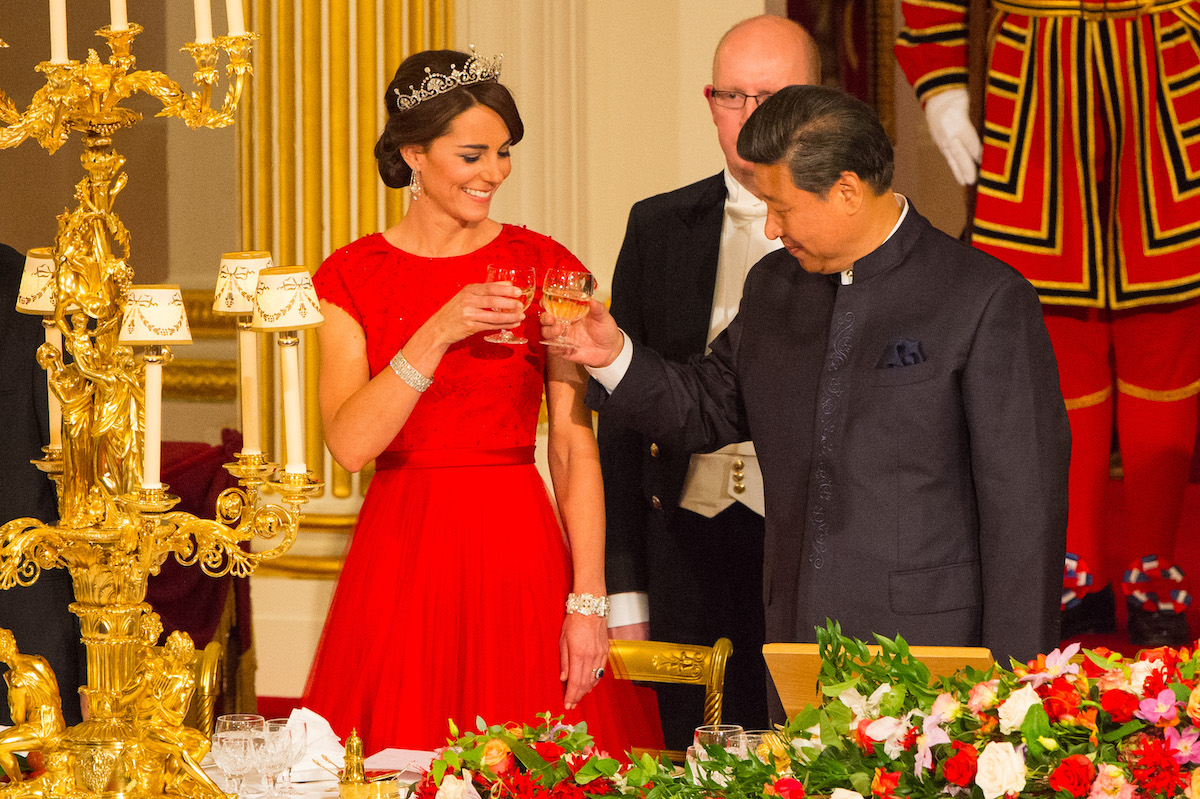
Kate has worn many tiaras since her wedding to Prince William in 2011, but one of her most memorable tiara moments came in Dec. 2013 when she chose to wear the Lotus Flower tiara with a pale blue gown at the annual diplomatic reception at Buckingham Palace. Also known as the Papyrus tiara, it was a favorite of Princess Margaret. The delicate style, which features dainty diamonds and pearls, was also worn by the Queen Mother.
The royal recycler is known to wear her favorite outfits over and over again and her choice of tiara is no exception. Already a master of diplomatic dressing, in 2015, Kate opted to wear the Lotus Flower tiara again (pictured here) at a state dinner given for the president of China, Xi Jinping, and paired the sparkling topper with a stunning red bespoke gown designed by Jenny Packham in a nod to China’s flag and the country’s cultural belief that red brings good luck and happiness.
One royal source told Best Life, “Catherine always puts a great deal of thought into what she wears and when to wear every item in her wardrobe. Wearing the Lotus Flower tiara a few years after joining the Royal Family was a subtle sign of confidence without being too showy. The duchess is the queen of understated elegance.”
RELATED: The One Thing the Queen Didn’t Like About Kate Early On, Says Insider.
The tiara that Meghan, Duchess of Sussex, wore when she married Prince Harry has a rich history dating back to the Queen’s grandmother.
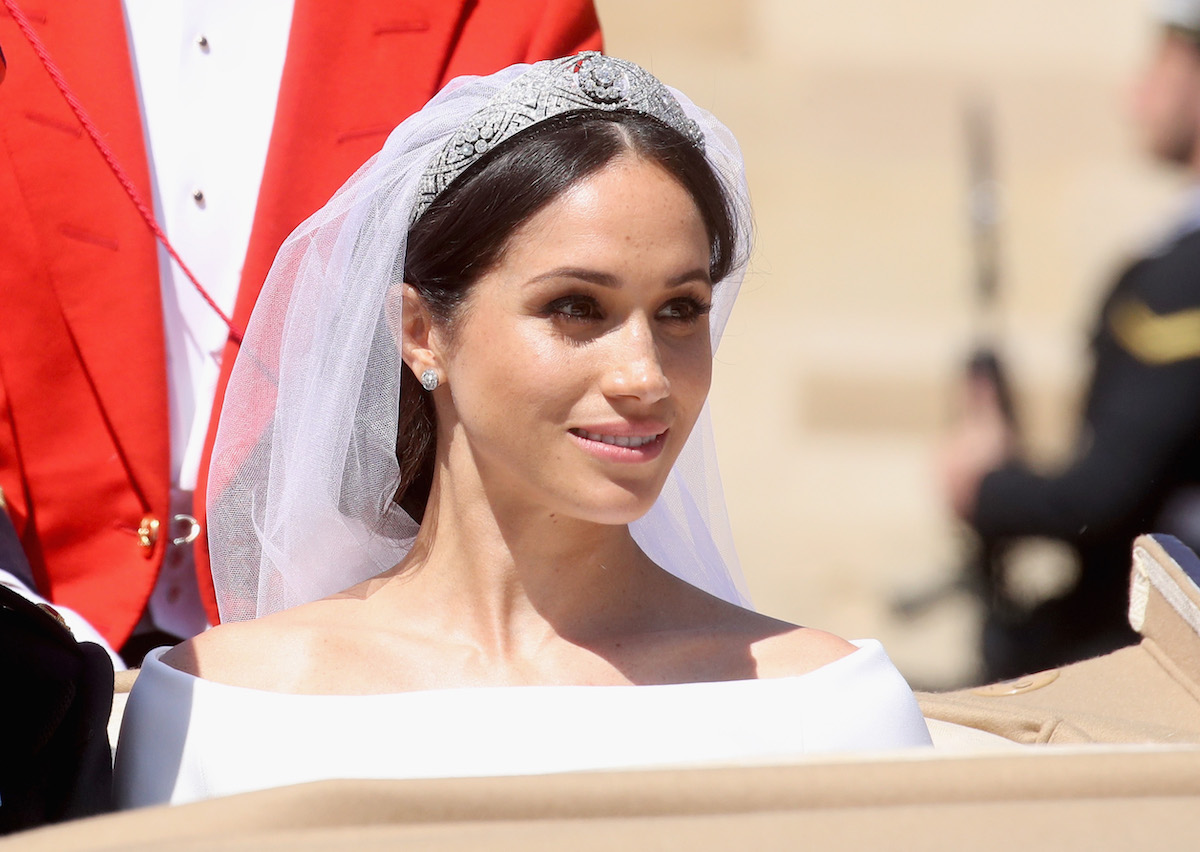
When she married Prince Harry in May 2018, Meghan, Duchess of Sussex, was loaned Queen Mary’s Bandeau tiara from Her Majesty’s private collection. The diamond headpiece originally belonged to the Queen’s grandmother, who had it created in 1932 using a diamond brooch she received as a gift when she married the future King George V in 1893. Queen Elizabeth inherited the tiara under the terms of her grandmother’s will when she died in 1953.
Stunning in its luxurious simplicity, the tiara was fashioned as a flexible headband design with sections of interconnected ovals and pavé diamonds set with large and small brilliant diamonds. Meghan wore Queen Mary’s detachable brooch of 10 brilliant diamonds as the center stone, but other royal women have worn the tiara with different stones at its center.
In 2019, the Duchess of Sussex told the story behind selecting the tiara in an audio recording for the royal wedding outfits exhibition at Windsor Castle (via the Los Angeles Times). “Harry and I had gone to Buckingham Palace to meet with Her Majesty, the Queen, to select one of the options that were there, which was an incredibly surreal day, as you can imagine,” she recalled. “That one, as we tried them on, stood out. I think it was just perfect because it was so clean and simple, and I think also, to that point, an extension to what [wedding gown designer] Clare [Waight Keller] and I had been trying to do with the dress, which was have something that could be so incredibly timeless but still feel modern.”
RELATED: This One Royal Will “Never Forgive” Harry and Meghan, Say Insiders.
Diane Clehane is a New York-based journalist and author of Imagining Diana and Diana: The Secrets of Her Style.